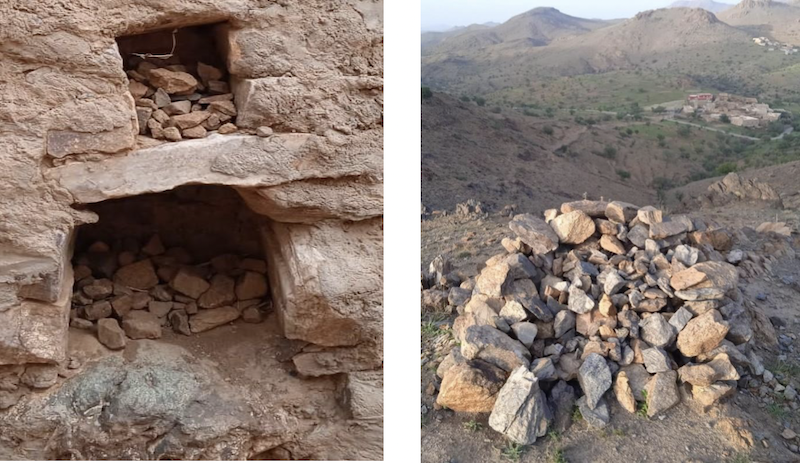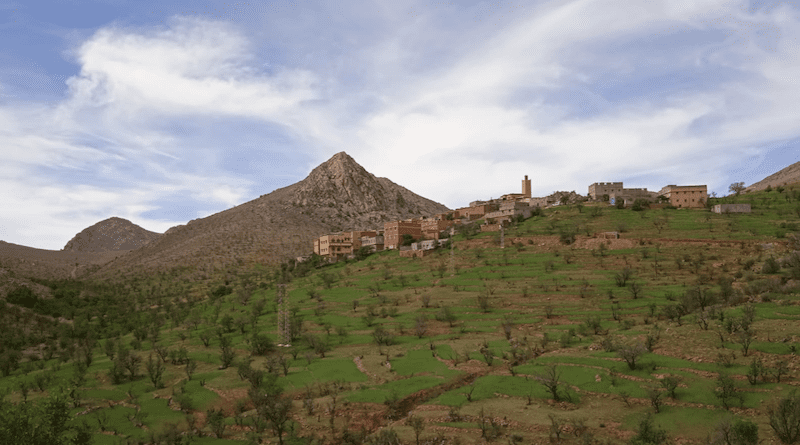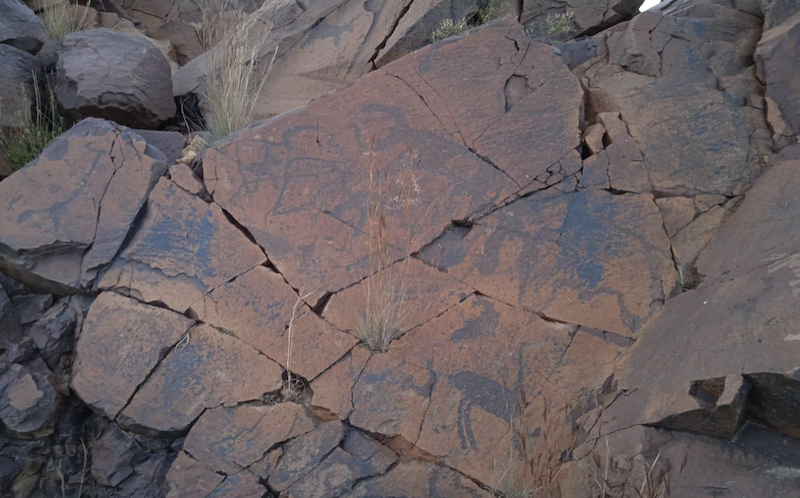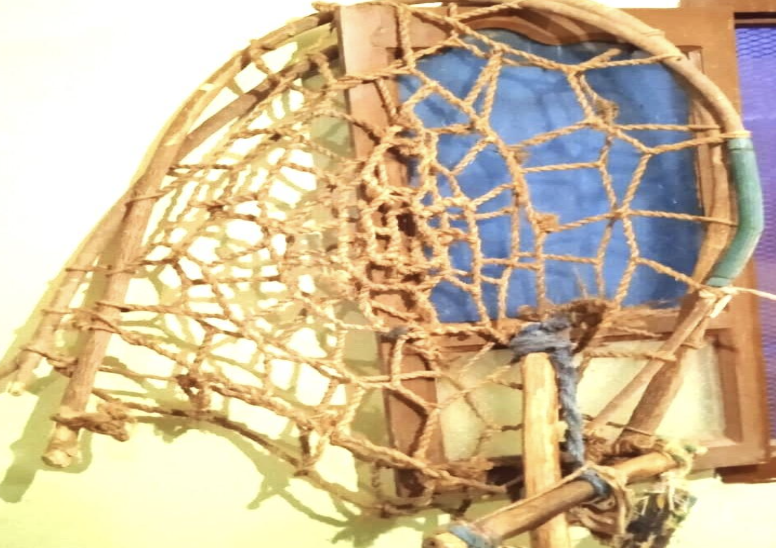Jewish Presence In The Oral Narratives Of Idda Ouzddout And Idda Ouknssous Tribes – Analysis
May 16, International Day of Living together in Peace, is a day to promote a vision for a sustainable world of peace. Recognizing and appreciating each other’s differences is not only integral to creating inclusive environments, but a prerequisite for advancing human development and planning for a shared future. HAF upholds its commitment to fostering peace and shared prosperity through the implementation of programs that promote interfaith solidarity and togetherness. Among these efforts is the USAID Dakira program. To mark the day, Dakira Cultural Coordinator Jamal reflects in this article on how past solidarity among Muslim and Jewish people in Ighrem has helped shape more inclusive communities in the region. The region’s appreciation of its diversity has served as a catalyst to social solidarity and peaceful coexistence.
Introduction
Nestled in the heart of the Anti-Atlas Mountains, Ighrem circle is located 80 km from the city of Taroudant. There are eight tribes governed under the administration of Ighrem: Idda Ouknssous, Idda Ouzddout, Idda Ounidif, Idda Ouzkri, Indouzal, Ayt Abd Ellah, Idda Ouska and Idda Oumartini. (1) Most residents of Ighrem came from Tamddoult n Aqqa after it was destroyed in the fourth century. (2) Prior to that, it was a flourishing trading city, which connected Southern Morocco and Sudan. (3) Residents first settled in Issafen for two centuries, and then dispersed again into the mountains due to various famines and epidemics. (4) In fact, the settlement in Ighrem is prehistoric, as illustrated by the engraved stones in Tafngha n Barka, Tighula, and Imgoune.
In addition, Ighrem is considered to be one of the most arid areas in Morocco. Nevertheless, the inhabitants have withstood the harsh climate conditions and frequent drought events by adopting the technique of terrace farming (5) to grow almond, olive, carob and Argan trees. These trees are drought-tolerant species that thrive in arid environments.
The tribes in Ighrem had their traditional institution of governance called Inflas (a tribal council appointed by the members of the tribe) that manages and resolves community disputes. Moreover, they built Igoudar (collective granaries), which are traditional Amazigh chambers used to store grains, legal documents, and jewelry. These structures are known as one of the oldest banking systems. In the Ighrem circle, there are also Quranic schools and shrines, around which the local people organize Ilmouggarn (festivals; sing.Almouggar). In spite of the various challenges they face, the communities grew attached to their rich cultural heritage, which includes three types of dances: Ahwash, Ahnqar and Ddrst. (6) These ritual dances are performed to different genres of local musical poetry during agricultural and social activities (7).
This article centers on the Jewish presence within the oral narratives of Ighrem communities that were collected between 2021 and 2023 as part of the USAID Dakira program, implemented by the High Atlas Foundation (HAF) and its partners. Interviews were conducted with community members (Dda Mbark, Dda Moubark, Ma Aicha, Dda Lhaj M, Dda Hmad, Dda Mhamed, Dda Lhaj Bou Tammnt, Dda Makhlouf, Dda Hassan) whose ages range between 30 and 120 years old. While some of them shared stories they’ve heard about the Jewish presence in the area, others reflected on their first-hand experiences with the Jewish communities. Our initial questions revolved around the tangible remains of the Jewish people and how they are remembered. The stories generated from the interviews were informative, and it is my aim, through this article, to unveil some aspects of the Jewish presence in the community’s local oral narratives.
Jewish people and local toponymy
The communities of Idda Ouzddout and Idda Ouknssous comprise diverse ethnic groups, including Igourrane (the descendants of the Marabouts, who are saints), Chourafa (the descendants of Prophet Mohammed), and Black and Jewish peoples. (8) Yet, the majority of people are Amazigh. Unlike in other parts of Morocco, the Jewish community in this rural area of Ighrem did not have a Mellah (Jewish quarter). As they engaged in trade and artisanal crafts during the weekly markets, they were often hosted by the local community (9) and hence developed a historical presence in the area. Despite the fact that the Jewish population in Ighrem was considered a minority, there are other forms of the Jewish presence reflected in the community’s local oral heritage.
Toponymy is a science devoted to the study of toponyms, (10) and it helps understand the origin of place names. Tigmi n Turg and Dar Waman are the names that the inhabitants assigned to their villages. They literally mean “the house of water” and “by the water” respectively. Villagers attribute the origin of the name to a canal that ran through the house and transported water from a spring to the village. Dar Waman is located near a place where rainwater can be stored easily for agricultural and daily use. Therefore, both names of the villages are associated with the abundance of water, which explains why the two villages are teeming with tall, ancient olive trees.
With this being said, what then is the relationship between the local toponymy and the presence of the Jewish community?
In Tagounite, Tafraout n Idda Ouzddout, there is a place called Ighzer n Mouchi (Ighzer is a secondary stream, and Mouchi is a Jewish name). It is named after a Jewish artisan who frequented the spot. There, he would work, making a wooden tool, called Iskni in Tachelhit, to transport the crops to the threshing field.
Moreover, people from Tigmi n Turg and Ait Makhlouf are familiar with a place called Dar Lqbr n Ouday, which is near the burial site of the Jewish artisan). Their ancestors gave it such a name because the site contains a Jewish grave. In an interview with some of the local people, Dda Hmad from Cimid village and Dda Lhaj from Idindi informed us that the grave belonged to a young Jewish man. In the past, a judge from Indindi allowed his family to bury his body on the border between Ait Makhlouf and Tigmi n Turg villages. Later, in the 1990s, the grave was relocated not far from its original location when a company paved a road over the original burial place. This site is still present in the daily life of the community members, as they use it as a reference point or landmark. For instance, they would say: “Let’s plough or reap the fields by Lqbr n Ouday” or “Let’s meet by Lqbr n Ouday.”
Religious interaction
It is possible that there were Jewish families who converted to Islam. Dda Driss said that Lemale, a French captain, wrote a monograph about the Idda Ouknsouss tribe in 1941, wherein he states that there were two Jewish families who ended up in Tafngha and Elmgrt villages that converted to Islam. Until recently, some community members discuss the lineage of the families who used to be Jewish, and even villages that bear Jewish names such as Ayt Makhlouf, Ayt Mousi (the villages in Tisfane were named after the Jewish families that once lived there), and Ayt Haroun (11) in Issafen. In Agouni n Lkhir village, a young man’s family name is Makhlouf, which is a source of pride to him. The family got the name from one of the clans of the village.
Saints, beliefs and rituals

Moroccan Muslims believe in the oneness and divinity of God and his prophet Mohammed. In addition, veneration of saints is a common practice among them.
According to some studies, 652 Jewish saints were identified in Morocco. Jewish people share 126 of these saints with Muslims; 16 are Muslim and also revered by Jewish people; 90 are Jewish and also honored by Muslim people; and 36 of them could have either been Jewish or Muslim–their religious identity is unknown today. (12)
Dda Mbark argued that Sidi Ikhfa, Sidi Lkouch and Sidi Mousi, in Tafraout n Idda Ouzddout, are not Muslim saints because such names are unusual among the local Muslim saints. He added that these saints do not have a relationship with any of the families in the nearby communities; thus, it is possible that they are of Jewish origin. Yet, the local people, who are Muslim today, take care of them and visit them regularly.
In Tagmut and Issafen, (13) which are not far from Ighrem, the shrines of Sidi Dunyal and Sidi Hazqil (or Walknnas) have probably existed for centuries. Local oral stories as well as Hebrew and Christian literature confirms that these are Jewish names. Both are considered Jewish saints who settled in the Tata province. Local and other people from the neighboring tribes (i.e.,Tagmut, Idda Ouknssous, Issafen, Tata) visit Sidi Dunyal shrine at any time of the day to seek his blessings. Every Friday morning, the Fouqaha and Oulama visit the shrine to read the Quran and the chants that praise the prophet. Sidi Dunyal, or Sidi Dunyane, as it is pronounced locally,) is known for his blessings that protect the residents of Tagmut from drought and floods. Some people believe that he can also cure people from severe illnesses, especially those with good intentions.
During periods of drought, the people in Souss do not only perform rain prayers, but they practice Almaarouf (14) rituals around the saints. It is a social occasion held by the members of the community, during which they sacrifice a bull and share a meal together. When they finish, they bring some food home to extend blessings to the house and the family. Usually, the meal consists of barley couscous. Such a ritual pertains to Sidi Ikhfa, Sidi Lkouch, and Sidi Mousa in Tafraout n Idda Ouzddout, and Sidi Dunyal in Tagmut and Sidi Walknnas in Issafen. Additionally, the Jewish community holds a ceremony (15) called Yaqoun hachim to pray for rain, and they fast and pray in their synagogues.
In Tafraout n Idda Ouzddout, local women visit the Sidi Ikhfa tomb, located in the corner of the village cemetery, to practice rituals that resemble those of Judaisim when visiting a tomb. In a hole in this tomb, the women leave a stone and a lit candle after praying to God to fulfill their wishes. They also prepare the Almaarouf meal at the site. The local people refer to such sacred sites as Tachkhin (sing. Tachikht).
Social and cultural interaction
The local people I spoke with had heard from their fathers and grandfathers about a few Jewish families who lived among the tribe of central Anti-Atlas Mountains. Ma Aicha, at 106 years old, recalled stories her father told her about the Jewish families who had fled from the area of Tindouf because of the plague. The Idda Ouzddout, Idda Ouknsouss, and Idda Ounidif tribes hosted them, and they have lived there ever since. Though community members may doubt the origins of some of the local families, they do not always declare so boldly. It is possible that these families might have converted to Islam from Judaisim ages ago. Dar Waman village, which is in Tafraout n Idda Ouzddout, was a stop for Jewish trading caravans that came from Oualqadi and headed to Ait Abd Allah and then to Tafraout n Ouaml. Jewish merchants from the caravans would stay there overnight, and locals would give them what they needed, sharing with them water stored in the village’s traditional reservoirs called Tinudfiwine (sing., Tanudfi).
On other occasions, local people would host Jewish vendors and artisans in their homes from as little a time as a single day to up to three months at a time. Some interviewees experienced these interactions personally, which provided them the opportunity to learn various crafts, such as sewing, from their Jewish guests. The local hosts were very aware of the Jewish rituals on Saturday and provided their guests with special items for Shabbat. When the harvest was bountiful, the locals borrowed more donkeys and mules for threshing, including those owned by the Jewish artisans. Jewish vendors and artisans exchanged items with them, and the latter were able to secure loans with flexible repayment deadlines. Dda Hassan from Tanammrt received such a loan from his Jewish friend Toulidanou in Meknes. Unable to imagine not paying him back, he managed to meet him again and pay his debt.
In the village of Dda Hassan and Ma Aicha, which is Tanamert of Idda Ouknsouss, a common Muslim and Jewish cemetery has existed for ages, and the villagers have always looked after it. First, they fenced it with a short wall of stones. Then, they added another fence of 1.5 meters, avoiding separating the Muslim section from the Jewish one. According to Ma Aicha’s story, the Jewish part is older than the Muslim part. The people there used to celebrate a festival of the saint Sidi Amar and his wife, who were buried in the cemetery. In 2022, members of the villages came together with the HAF’s Dakira program team to celebrate this tangible heritage through community dialogue and by sharing stories of the Jewish community in the central Anti-Atlas Mountains.
The active Jewish people in Ighrem communicated in Tachelhit. As we were advancing with interviewing the community members, we repeatedly heard the following verses drafted by a Jewish man:
Tachelhit: Udayn urda krzn ula qqayn aman
Ijudasn rbbi gh lksut ula tiram
English: The Jewish people do not plough nor water the fields
God blessed their food and their clothes
The verses reflect the special status Jewish people enjoyed as traders and craftsmen instead of engaging in agricultural activities, at least in this rural area of central Anti-Atlas Mountains.
Later on, we met Lhaj Bu Tammnt, 120 years old, who told us that the verses were from a man he knew named Hnni. He had recited them during Almouggar, the moussem (festival) of Ayt Kourban in the nearby Ouaklim Mountains. This shows that Jewish people also attended religious and cultural activities like Almouggar in the past. Lhaj Bu Tammnt and Hnni were close partners in trade in Ighrem and its villages. Massa Fatima from Ighrem also recalls the times when Jewish women attended wedding parties, beautifully singing Tizrrarin (16) and handing gifts to their Muslim friends.
Dda Moubark, from Dar Waman village, said that his grandfather dealt with the Jewish traders in Irazane and Riad Zitoune in Marrakech. He is grateful for the friendship between his grandfather and members of the Jewish community. They would always warmly welcome him before they started talking about business. Business with them was beneficial to his grandfather and so also to his family and the community. Dda Moubark said God blessed the activities of the Jewish people because they practice their religion righteously. They do not waste their time, and they are always at the service of others. They had also mastered trade and craftsmanship.
The Jewish community and the customary law – the market
Before the French administration in Morocco, the courts relied on three sources of law (17): Islamic law, Hebrew law, and customary law created by the tribes and their leaders. In his book, Moukhtar Soussi states (18) that the Soussi tribes invented their laws and rules which organize their social, economic, and political life. In this regard, they imposed punishments on those who commit violent acts and robbery in the markets, ilmouggarn (festivals), igoudar (collective granaries), and mellahs (Jewish quarters). The customary law protects members of the Jewish community in the markets and in their routes to it. The inflas (tribal councils)institution was responsible for the application of this conventional law in different public spaces of the tribe. (19)
According to one of the interviewees, residents from different villages within Ighrem once witnessed a fight between a Jewish man and a Muslim man at the weekly Tuesday market in Nihit of Idda Ouzddout. Although customary law punishes people involved in such a situation, the villagers reconciled the issue themselves. Therefore, they respected the sanctity of the market through their socialization, which is not only based on religion but on customary law, old traditions, customs, and beliefs as well.
The markets and the almouggars, or moussems (annual religious festivals around the saints) were hallmark public spaces where members of the Jewish community mingled with the local people from different villages. (20) In the southern part of Morocco, there is a common saying that reads as follows (21): “a market without Jewish people is like bread without salt.” Thus, the villagers and the Jewish community complemented (22) one another in terms of skills and occupation, especially since trade between the two communities was based on exchanging goods and services.
Conclusion
In the 1950s and 1960s, the Jewish community left the mountains, the valleys, and the oases of southern Morocco. However, they are still present in the memories of the local rural communities whose oral stories have preserved various forms of the Jewish presence in tangible and intangible spaces. Overall, this presence has been possible through popular cultural and social solidarity (23) that is manifested in the everyday lives of the people–in communal public areas, local markets, religious and social festivals, tribal spaces, and even in local toponymy.
Jamal Maghiouzi was born in Tinghir, Morocco. He obtained a Bachelor’s degree in English Studies from Caddi Ayyad University. While conducting field work and volunteering, he developed an interest in anthropology and ethnography. Jamal joined the High Atlas Foundation (HAF) as a cultural coordinator for the USAID Dakira in November 2021.
This article is part of the Heritage Month in Morocco campaign (April18 – May 18) that celebrates the Kingdom’s rich heritage, as part of the USAID Dakira Program, which is implemented by the High Atlas Foundation and its partners. The program aims to strengthen inter-religious and inter-ethnic solidarity through community efforts that preserve cultural heritage in Morocco.
The article was completed with the support of the United States Agency for International Development (USAID), and the High Atlas Foundation is solely responsible for its content, which does not necessarily reflect the views of USAID or the Government of the United States.
Endnotes:
- Youssef Boukdir, Ighrem. June 02, 2011
- Mohamed, Moustaoui. Abd Ellah, Kiker. The Tribe of Idda Ouzddout, Space and the Memory. The first edition 2019. Edition Dar Assalam, Rabat.
- Nazha, Elamrani. The Historical forts “Igudar” and their Role in Moroccan National Economy. Edition of 2019. Matbaat Ennajah Al Jadida (CTP). Casablanca
- Youssef Boukdir, Ighrem. June 02, 2011
- A method used to grow crops and fruitful trees on sides of mountains. This technique helps protect sloped land from erosion and water loss.
- Local collective Amazigh dance and musical performance from the south of Morocco.
- Rachida, Bouklij. Fatima, Messaoui. The Oral Amazigh Poetry in Ighrem: Tazrrart and Tamawacht. 2014/2013. Ibn Zohr University.
- Mohamed, Moustaoui. Abd Ellah, Kiker. The Tribe of Idda Ouzddout, the Space And the Memory
- Mohamed, Moustaoui. Abd Ellah, Kiker. The Tribe of Idda Ouzddout, the Space And the Memory
- Lhoussaine, Rachid. The Memory Imprint, Amazigh Landmarks in the National Culture. Institut Royal de la Culture Amazighe. 2004/2324. Amaarif Al Jadida. Rabat
- Mohamed, El Safi. Manifestations of the social life of the Jewish community in the Bani region during the 19th century. Journal of Heritage and Arts of Southern Morocco. Number 02. Edition 2022. Amin Graf. Sala
- Rachid, Rabia. Manifestations of peaceful coexistence between religions through the relationship of Moroccan Jews with the Makhzen during the extended 19th century. Journal of Heritage and Arts of Southern Morocco. Number 02. Edition 2022. Amin Graf. Sala
- Brahim, Amrki. Said, Elhilali. The Memory of Tagmut n Yaqub between Now and then. Edition 2018. Matbaat Soumakram. Casablanca
- Mohamed, Ait Jamal. The Epidemics and the Famines in Souss and Ouad Noun between 1900 and 1945. First edition 2020. Dar Abi Raqraq for Editing & Printing
- Mohamed, Ait Jamal. The Epidemics and the Famines in Souss and Ouad Noun between 1900 and 1945.
- Amazigh poems and chants that are performed during social occasions like wedding ceremonies.
- El Zoubir, Mahdad. From Moroccan Amazigh Culture. Afriqia Acharq, 2022. Casablanca
- Ibid.
- Rachid, Chhimi. Abd Elmajid, Amarigh. Legal Documentation between the Jewish People and the Muslims in Southern Morocco from the 16th century to the French Protectorate. Journal of Heritage and Arts of Southern Morocco. Number 02. Edition 2022. Amin Graf. Sala
- Elhasane, Anzoula, The Jewish Heritage in the Desert Areas, Guelmim as a model. Journal of Heritage and Arts of Southern Morocco. Number 02. Edition 2022. Amin Graf. Sala
- Ibid.
- Joseph, Yossi Chetrit. Intimacy, Cooperation and Ambivalence, Social, Economic and Cultural Interaction between Jews and Berbers in Morocco. Volume 52, No. 2, Autumn 2019. European Judaism
- Hassan, Achrwaw. Religious Tolerance in Popular Religiosity in Morocco: Anthropological approach of Jewish presence in religious festivals in Souss. 2018. Mominoun without Borders for studies and research.
References
Brahim, Amrki. Said, Elhilali. The Memory of Tagmut n Yaqub between Now and then. Edition 2018. Matbaat Soumakram. Casablanca
El Hassan, Anzoula. The Jewish Heritage in Saharian Spaces –Goulmim as an example- . Journal of Heritage and Arts of Southern Morocco. Number 02. Edition 2022. Amin Graf. Sala
El Zoubir, Mahdad. From Moroccan Amazigh Culture. Afriqia Acharq, 2022. Casablanca
Hassan, Achrwaw. Religious Tolerance in Popular Religiosity in Morocco: Anthropological approach of Jewish presence in religious festivals in Souss. Copyright 2018. Mominoun without Borders for studies and research. www.mominoun.com
Joseph, Yossi Chetrit. Intimacy, Cooperation and Ambivalence, Social, Economic and Cultural Interaction between Jews and Berbers in Morocco. Volume 52, No. 2, Autumn 2019. European Judaism
Lhoussain, Rachid. The Memory Imprint, Amazigh Landmarks in the National Culture. Institut Royal de la Culture Amazighe. 2004/2324. Amaarif Al Jadida. Rabat.
Mohamed, Ait Jamal. The Epidemics and the Famines in Souss and Ouad Noun between 1900 and 1945. First edition 2020. Dar Abi Raqraq for Editing & Printing
Mohamed, El Safi. Manifestations of the social life of the Jewish community in the Bani region during the 19th century. Journal of Heritage and Arts of Southern Morocco. Number 02. Edition 2022. Amin Graf. Sala.
Mohamed, Moustaoui. Abd Ellah, Kiker. The Tribe of Idda Ouzddout, the Space and the Memory. The first edition 2019. Edition Dar Assalam, Rabat.
Nazha, Elamrani. The Historical forts “Igudar” and their Role in Moroccan National Economy. Edition of 2019. Matbaat Ennajah Al Jadida (CTP). Casablanca
Rachida, Bouklij. Fatima, Messaoui. The Oral Amazigh Poetry in Ighrem: Tazrrart and Tamawacht. 2014/2013. Research. Iben Zohr University.
Rachid, Chhimi. Abd Elmajid, Amarigh. Legal Documentation between the Jewish People and the Muslims in Southern Morocco from the 16th century to the French Protectorate. Journal of Heritage and Arts of Southern Morocco. Number 02. Edition 2022. Amin Graf. Sala
Rachid, Rabia. Manifestations of Peaceful Coexistence between Religions through the Relationship of Moroccan Jews with the Makhzen during the extended 19th century. Journal of Heritage and Arts of Southern Morocco. Number 02. Edition 2022. Amin Graf. Sala
Youssef, Boukdir. Ighrem. June 02, 2011 https://afayane.com/%d8%a5%d8%ba%d8%b1%d9%85/



